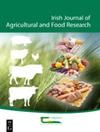三种海洋中上层鱼类的近似组成:蓝鳕鱼(Micromeristius poutassou)、野猪鱼(Capros aper)和大西洋鲱鱼(Clupea harengus)
IF 1.4
4区 农林科学
Q3 AGRICULTURE, MULTIDISCIPLINARY
引用次数: 5
摘要
这项研究提供了对三种海洋鱼类的深入接近成分分析的数据:蓝鳕鱼(Micromeristius poutassou)、野猪鱼(Capros aper)和大西洋鲱鱼(Clupea harengus)。这些鱼含有大量的蛋白质(16-17%)、脂质(4-11%)和矿物质(2-6%灰分)。这些蛋白质,特别是来自野猪的蛋白质,具有接近人类和鱼类营养的最佳氨基酸图谱。就总脂质和ω-3脂肪酸二十二碳六烯酸和二十碳五烯酸的相对浓度而言,它们与其他鱼类相比是有利的(三酰基甘油[TG]中分别为11.8-13.3%和5.9-8.1%,磷脂[PL]中分别是24.6-35.4%和5.8-12.0%)。大西洋鲱鱼的脂质含量在三种鱼类中最高,并被发现含有高水平的PL多不饱和脂肪酸,包括ω-3脂肪酸。在该鱼中检测到的矿物质包括钙(272–1520 mg/100 g)、磷(363–789 mg/100 g。除钾外,河豚的灰分含量最高,所有矿物质含量也最高。与其他两种鲱鱼相比,大西洋鲱鱼的矿物质含量要低得多,而且检测到的含量也低于之前发表的研究报告中的水平。对重金属含量进行了量化,重金属含量明显低于除砷以外的所有元素的最高允许限量,这三种鱼类的砷含量在1.34至2.44毫克/公斤之间。此处列出的数据将有助于指导产品开发。未来的研究将受益于考虑鱼类的捕捞季节、性别和发育阶段。本文章由计算机程序翻译,如有差异,请以英文原文为准。
The proximate composition of three marine pelagic fish: blue whiting (Micromesistius poutassou), boarfish (Capros aper) and Atlantic herring (Clupea harengus)
This study presents data from an in-depth proximate compositional analysis of three marine fish species: blue whiting (Micromesistius poutassou), boarfish (Capros aper) and Atlantic herring (Clupea harengus). These fish contained significant amounts of protein (16–17%), lipids (4–11%) and minerals (2–6% ash). The proteins, particularly from boarfish, had close to optimum amino acid profiles for human and fish nutrition. They compared favourably with other fish species in terms of total lipids and relative concentration of the omega-3 fatty acids docosahexaenoic acid and eicosapentaenoic acid (11.8–13.3% and 5.9–8.1% in triacylglycerols [TG] and 24.6–35.4% and 5.8–12.0% in phospholipids [PL]). Atlantic herring had the highest lipid content among the three fish and was found to contain high levels of PL poly-unsaturated fatty acids, including omega-3 fatty acids. Minerals detected in the fish included calcium (272–1,520 mg/100 g), phosphorus (363–789 mg/100 g), iron (1.07–2.83 mg/100 g), magnesium (40.70–62.10 mg/100 g), potassium (112.00–267.00 mg/100 g), selenium (0.04–0.06 mg/100 g), sodium (218.00–282.00 mg/100 g) and zinc (1.29–5.57 mg/100 g). Boarfish had the highest ash fraction and also the highest levels of all the minerals, except potassium. Atlantic herring had considerably lower mineral content compared with the other two species and, levels detected were also lower than those reported in previously published studies. Heavy metals contents were quantified, and levels were significantly below the maximum allowable limits for all elements except arsenic, which ranged from 1.34 to 2.44 mg/kg in the three fish species. Data outlined here will be useful for guiding product development. Future studies would benefit from considering catch season, sex and developmental stage of the fish.
求助全文
通过发布文献求助,成功后即可免费获取论文全文。
去求助
来源期刊
CiteScore
2.50
自引率
20.00%
发文量
23
审稿时长
>36 weeks
期刊介绍:
The Irish Journal of Agricultural and Food Research is a peer reviewed open access scientific journal published by Teagasc (Agriculture and Food Development Authority, Ireland). Manuscripts on any aspect of research of direct relevance to Irish agriculture and food production, including plant and animal sciences, food science, agri environmental science, soils, engineering, buildings, economics and sociology, will be considered for publication. The work must demonstrate novelty and relevance to the field of research. Papers published or offered for publication elsewhere will not be considered, but the publication of an abstract does not preclude the publication of the full paper in this journal.

 求助内容:
求助内容: 应助结果提醒方式:
应助结果提醒方式:


